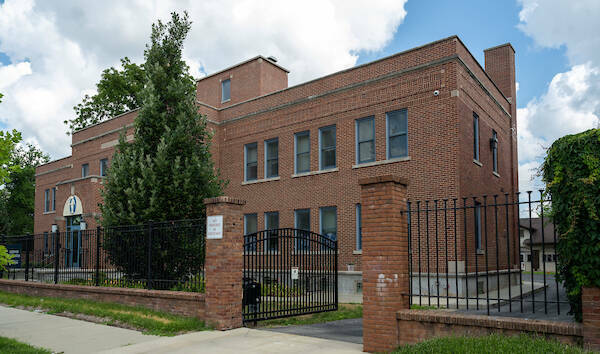Facilities

Located within the West Washington National Historic Register District, the building at 1045 W. Washington St. was built in 1925 as the Children’s Dispensary, where free and reduced medical care was available to families without financial resources. It was later named after the Dispensary’s founder, Dr. Charles Hansel. The facility has also served as a neighborhood center and as the administrative offices for Head Start. The building contains more than 10,000 square feet of space on two floors and nearly 4,000 square feet in the basement.
Vacant since 2003, the building underwent a $2.5 million renovation project in 2012 through a partnership with the University of Notre Dame, the South Bend Heritage Foundation, Dorene Dominguez and Vanir Construction Management. Federal Community Development Block Grants were also used to finance some of the project. The foundation and University led fundraising efforts among local businesses and philanthropic organizations, including the Notre Dame Institute for Latino Studies, the Community Foundation of St. Joseph County, the Florence V. Carroll Charitable Trust, the Saint Joseph Regional Medical Center and several other generous contributors.
In 2013, the Notre Dame Center for Arts and Culture was established to house a Crossroads Gallery, Segura Arts Studio, Notre Dame's Office of Community Relations, and Educational Programming. After 6 years in operation, the Crossroads Gallery, Segura Arts Studio, and Office of Community Relations transitioned away from the location and the University's Center for Civic Innovation (CCI) re-located from Innovation Park. The original Educational Programming remains in the building as part of CCI.
History of the Building (A Historic Landmark - Notre Dame Center for Arts and Culture)
This building was built as the Children’s Dispensary. The Children’s Dispensary and Hospital Association was founded in 1909 by Charles E. Hansel with Dr. J.B. Berteling in an effort to lower South Bend’s child mortality rates. The Dispensary’s first location was in an old cigar store at 1029 W. Division (Western Ave.) Until 1912, the Dispensary’s main function was the distribution of free milk during the summer months. Around 1917, the Children’s Dispensary moved to a house at 1040 W. Division and expanded their services to include medical and dental care. By 1922, it was apparent that the Dispensary’s new location was too small for their growing services, and a new building campaign was started.
On March 19, 1925, the cornerstone of the new hospital was laid. Designed by Willard M. Ellwood, a local architect, the new dispensary and hospital had thirty rooms, a gymnasium, and elevator leading to a roof sun deck. The fireproof building was designed with terrazzo floors and iron stairways. Placed above the entrance door is a terra-cotta reproduction of Bambino by Luca Della Robbia.
The Dispensary offered free medical check-ups for children up to the age of sixteen, along with orthopedic care, dental care, nutritional services (i.e. free milk), and eye and ear care. In addition, the Children’s Dispensary offered classes and clubs for boys and girls as well as their mothers.
In 1951, the milk fund was discontinued, and in 1956 the gymnasium was turned over to the South Bend Parks and Recreation Board for use by the senior citizens. On December 3, 1966, all medical operations of the Dispensary were turned over to Memorial and St. Joseph Hospitals and the building was rented to United Community Services. Although the Children’s Dispensary Hospital was closed, the Children’s Dispensary and Hospital Association is still in existence and continues to operate Camp Millhouse, which began in 1940, an outgrowth of earlier summer camps.
In 1966, the building’s name was changed to Hansel Center after Dr. Hansel and it became one of South Bend’s neighborhood centers. The Hansel Center later became administrative offices for the federal Head Start preschool program until 2003, when it was vacated. An extensive renovation was completed in late 2012, and the Notre Dame Center for Arts & Culture (NDCAC) officially opened in March 2013. When NDCAC sunsetted in 2019 the Notre Dame Center for Civic Innovation began operating within the building.